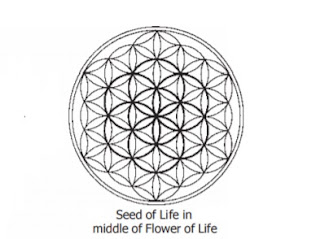THE FLOWER OF LIFE
This image of the Flower of Life is being found all over the world.
It is found in Sweden, Finland, Iceland, Yucatan, Ireland, Turkey,
England, Israel, Egypt, China, Tibet, Greece and Japane. It is found
everywhere. Almost everywhere around the world it has the same name,
which is the Flower of Life, though elsewhere around the cosmos it
has other names. Two of the main names would be translated as the
Language of Silence and the Language of Light. It is the source of
all languages. It is the primal language of the universe, pure shape
and proportion. It is called a flower, not just because it looks like
a flower, but because it represents the cycle of a fruit tree. The
fruit tree makes a little flower, which goes through a metamorphosis
and turns into a fruit - a cherry or an apple or something. The fruit
contains within it the seed, which falls to the ground, then grows
into another tree. So there is a cycle of tree to flower to fruit to
seed and back to a tree again, in these five steps. This is an
absolute miracle. But you know, it just goes right over our heads. It
is so normal that we simply accept it and do not think much about it.
The five simple, miraculous steps in this cycle of life actually
parallel the geometries of life.
The Seed of Life
In the middle of the
Flower of Life are seven interconnected circles which, if you take
them out and draw a circle around them, would create the image called
the Seed of Life.
The Tree of Life Connection
Another
image in this pattern, which you are probably more familiar with, is
called the Tree of Life. Many people have thought that the Tree of
Life originated with the Jews or Hebrews, but it did not. The
kabbalah did not originate the Tree of Life, and there is proof. The
Tree of Life does not belong to any culture not even the Egyptians,
who carved the Tree of Life on two sets of three pillars in Egypt at
both Karnak and Luxor around 5000 years ago. It is outside any race
or religion. It is a pattern that is intimately part of nature. If
you go to distant planets where there is consciousness, you will find
the same image.
So if we have a
tree, then a flower, then a seed, and if these geometries do in fact
parallel the five cycles of a fruit tree that we see on Earth, then
the source of the tree would have to be perfectly contained within
the seed. If we take the images of the Seed of Life and the Tree of
Life and superimpose them, we can see the relationship.
The Vesica Piscis
In
sacred geometry there is a pattern that looks like pictures below. It
is formed when the centers of two equal-radius circles are placed on
each others circumferences. The area where the two circles intersect
forms what is called vesica piscis. This configuration is one of the
most predominant and important of all relationships in sacred
geometry.
There are two measurements in the vesica piscis. One that runs through the center across the narrow width, and one that connects one point to the opposite point through the center. That are keys to a great knowledge within this information. What many people do not know is that every line in the Tree of Life, whether it has 10 or 12 circles, measures out to either the length or the width of a vesica piscis in the Flower of Life. And they all have Golden Mean proportions. If you look carefully at the superimposed Tree of Life, you will see that every line corresponds exactly to either the length or the width of a vesica piscis.
There are two measurements in the vesica piscis. One that runs through the center across the narrow width, and one that connects one point to the opposite point through the center. That are keys to a great knowledge within this information. What many people do not know is that every line in the Tree of Life, whether it has 10 or 12 circles, measures out to either the length or the width of a vesica piscis in the Flower of Life. And they all have Golden Mean proportions. If you look carefully at the superimposed Tree of Life, you will see that every line corresponds exactly to either the length or the width of a vesica piscis.










Comments
Post a Comment